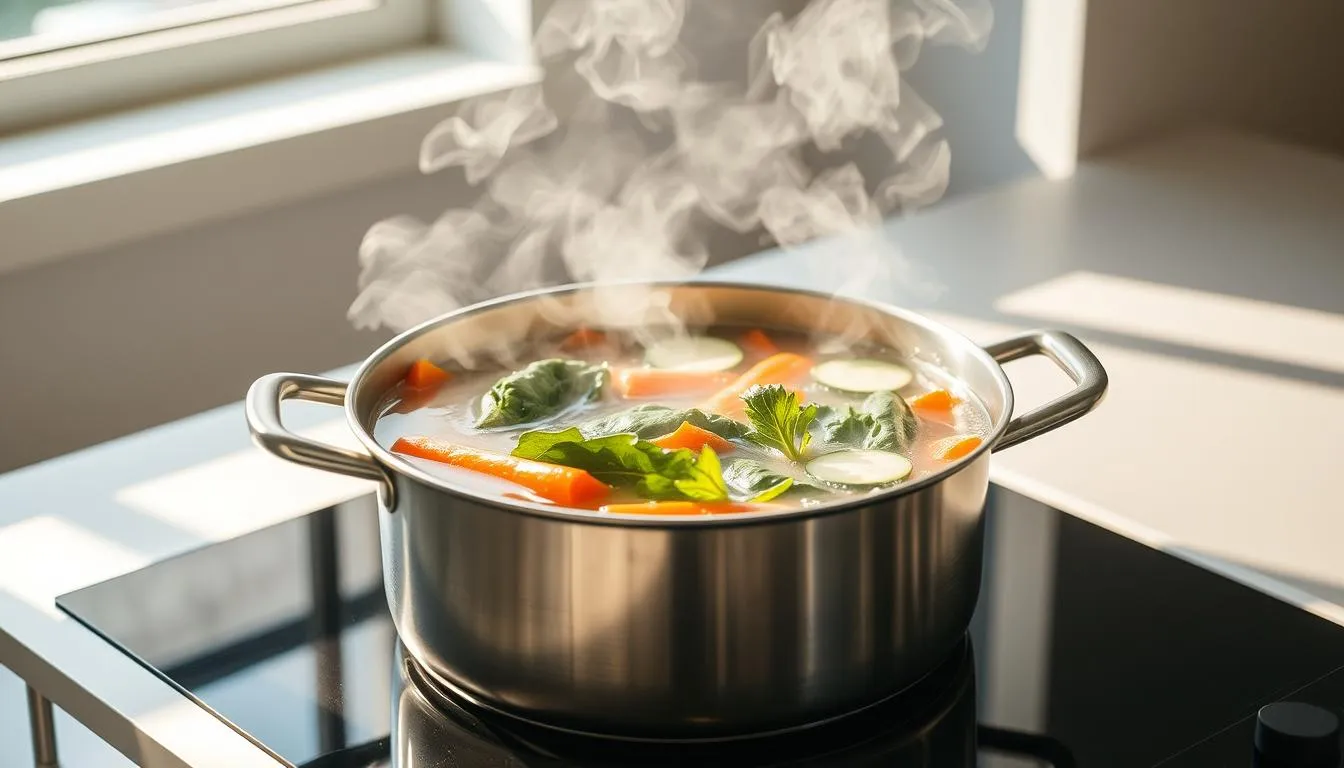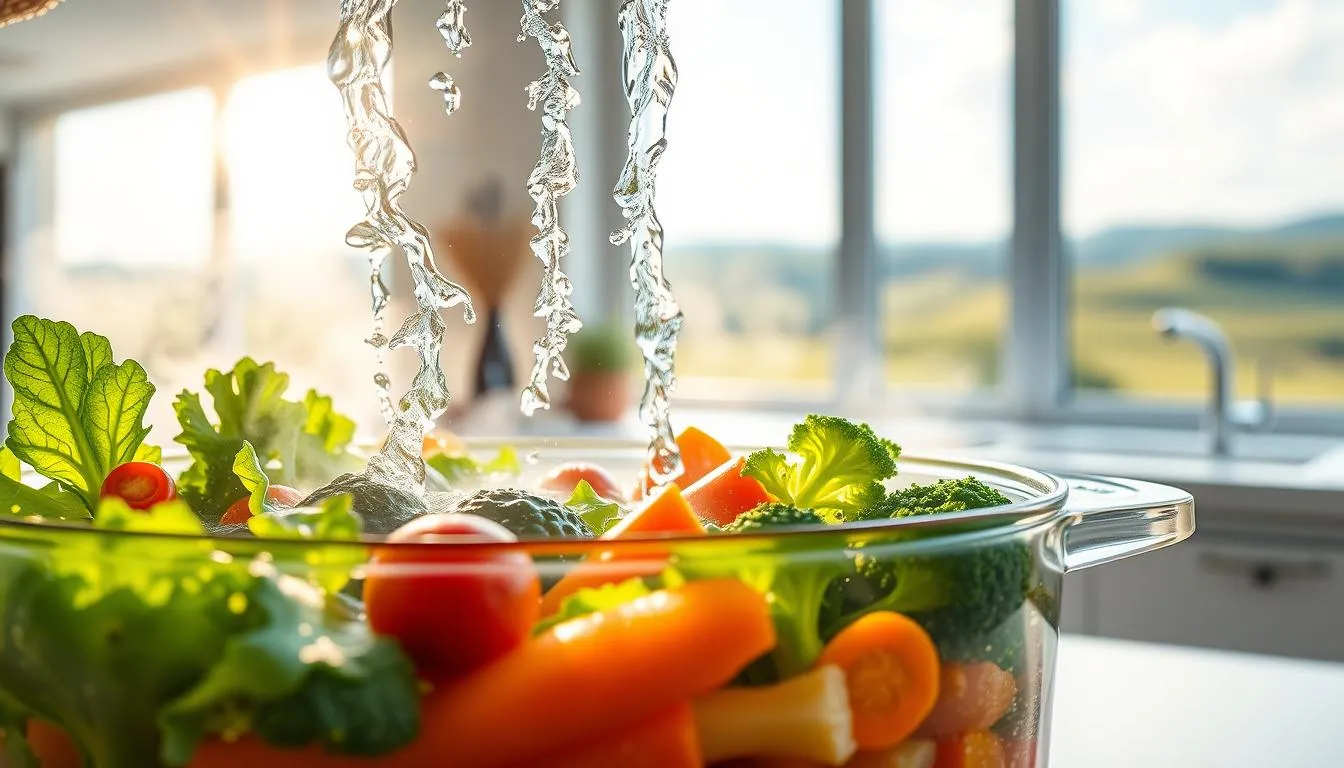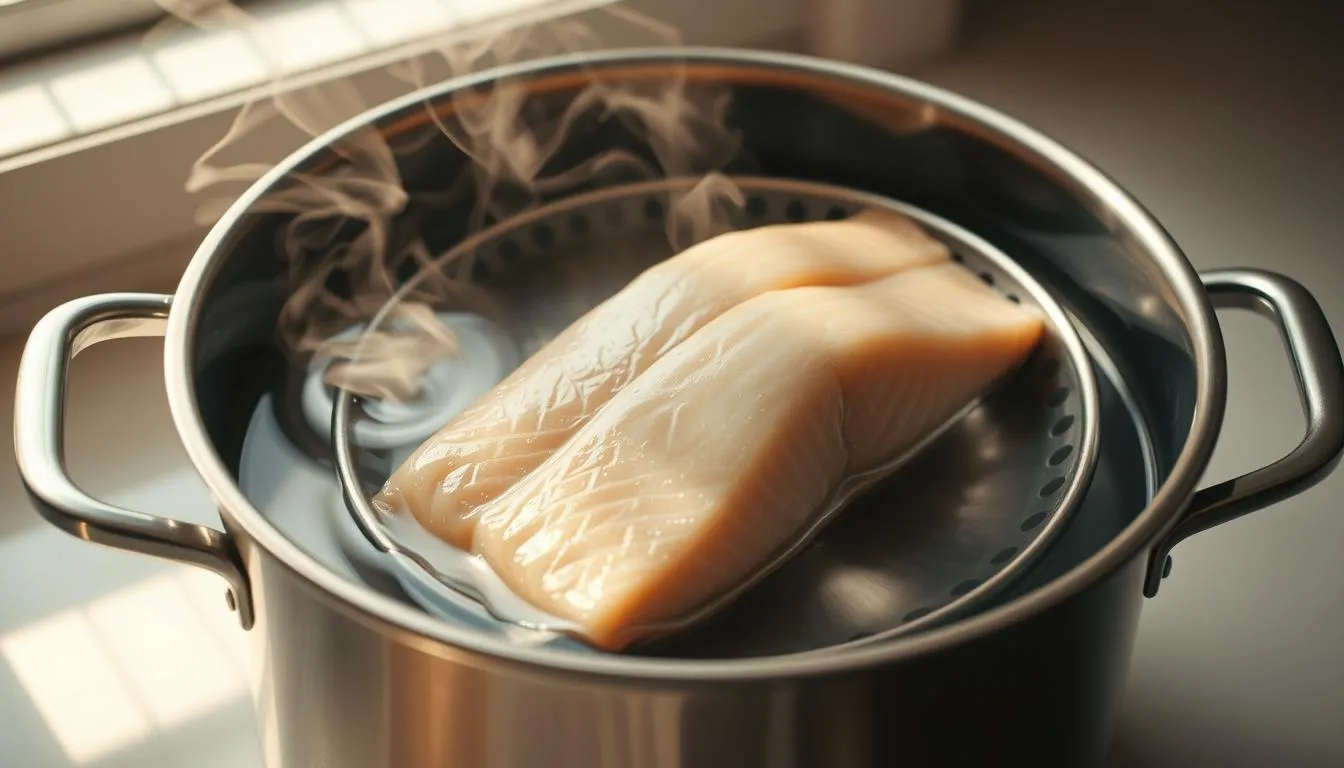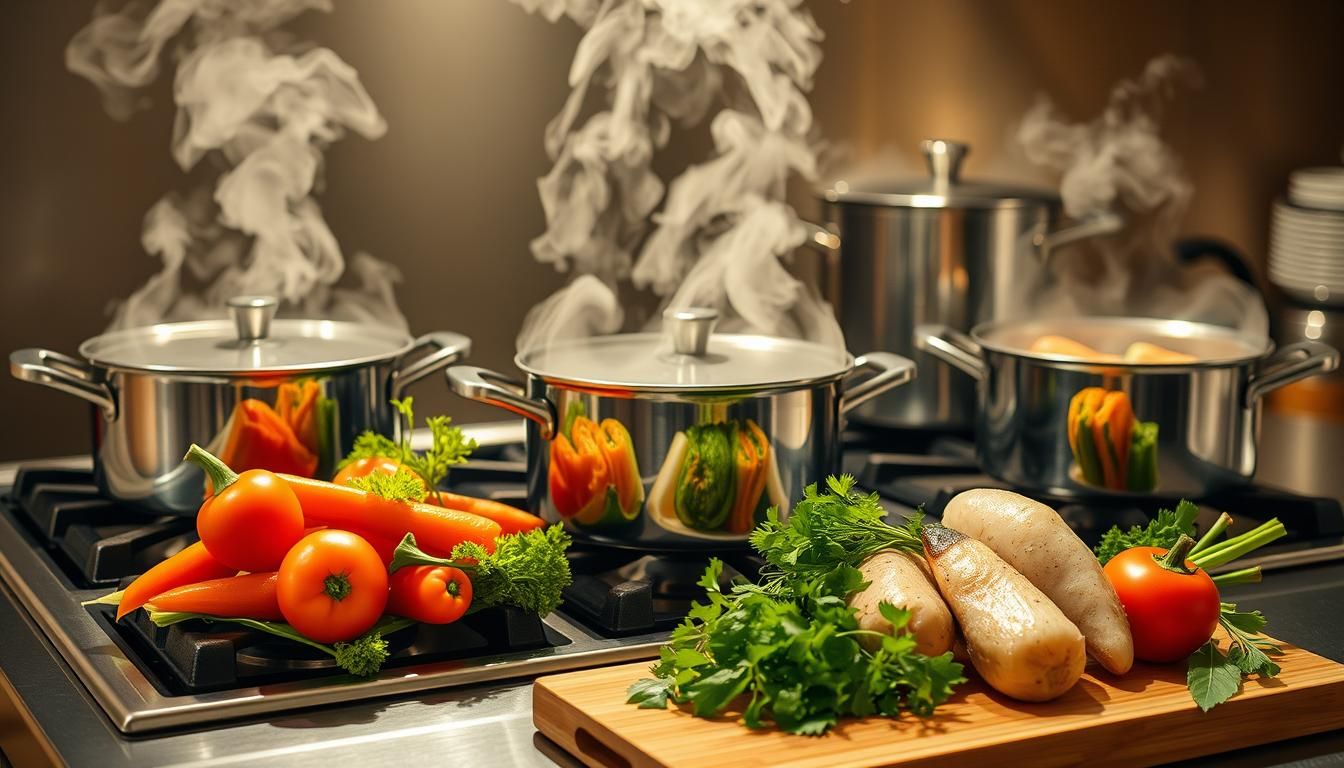I still remember the first time my grandmother taught me to steam greens in her tiny Brooklyn kitchen. The house smelled like lemon and thyme, and the meal felt like comfort and care. That memory taught me that simple techniques can make food taste better and feel kinder to our bodies.
These gentle approaches—steaming, poaching, braising, and simmering—give you control over texture and flavor without fuss or fancy gear. They shrink added oil, help protect vitamins, and lower harmful byproducts linked to high dry heat.
In this article you’ll learn clear steps for everyday meals and which foods respond best to each approach. You’ll also find practical tips that fit busy American kitchens and the flavors you love.
For a deeper look at the health science and benefits behind these techniques, see this guide on water-based cooking benefits.
Key Takeaways
- Gentle, moist heat can cut added fats and preserve nutrients.
- Steaming and poaching protect delicate proteins and veggies.
- Braising unlocks flavor and tenderness for tougher cuts.
- These cooking methods reduce harmful high-heat compounds.
- Practical tips will help you make these approaches part of your routine.
What water-based cooking is and why it’s trending now
Across kitchens and feeds, more home cooks are choosing gentler ways to prepare favorite plates. Searches for water-based cooking rose through 2024 as social posts and the “air fryer effect” nudged people away from heavy oil. The result: renewed interest in simple, lower-heat approaches.

Present-day interest: the health spotlight and the “air fryer effect”
Short videos showed how less hot oil still creates satisfying texture. That pushed many to try alternatives that cut added fat without losing flavor.
People want easy wins: familiar dishes with less fuss, and reliable results for weeknight meals.
Moist heat in a nutshell: cooking with water, steam, and flavorful liquid
At its core, water-based cooking is a family of approaches—steaming, boiling, simmering, poaching, blanching, and braising—that use liquid to transfer heat. These techniques work at lower, steadier temperatures than dry-heat frying.
They keep food moist, protect delicate proteins like fish and chicken, and let you build flavor by simmering herbs or stock. No special gadget required: a pot, a lid, and a steamer basket go a long way. For specific healthy fish preparations using these techniques, check out our salmon recipe collection.
Health benefits of water-based cooking you can taste
Small swaps in how you cook can make a big difference to flavor and nutrition on your plate.
Preserving water‑soluble vitamins and minerals in vegetables
Steaming keeps vitamins and minerals intact. When you steam or simmer in a broth that becomes part of the dish, most nutrients stay in your meal.
Boiling can pull vitamin C and other water‑soluble vitamins into discarded liquid. If you must boil, keep times short or reuse the cooking liquid in sauces or soups.
Lower fat and calorie content without hot oil
Gentle, moist heat reduces the need for added oil. That lowers total fat and cuts calories while keeping food moist and satisfying.
Poaching in stock or a light sauce adds flavor without the extra grease of pan‑frying.
Reducing advanced glycation end-products (AGEs) with moist heat
High dry heat creates more AGEs, compounds linked to inflammation. Methods like steaming or poaching produce fewer of these byproducts.
For grill or roast nights, a quick acidic marinade (lemon or vinegar) helps limit AGE formation while preserving the taste you want.

| Goal | Best approach | Why it helps |
|---|---|---|
| Protect vitamins in vegetables | Steaming or simmering in broth | Limits nutrient loss and keeps minerals in the dish |
| Lower fat and calories | Poaching, steaming | Needs little or no added oil |
| Cut AGEs from high heat | Moist heat; use acidic marinades for grilling | Reduces harmful compounds while keeping flavor |
| Quick weeknight meals | Short steaming or one‑pot simmer | Fast, flavorful, and nutrient‑friendly |
Water‑based cooking methods: a practical how‑to guide
A few simple steps turn everyday pots and pans into reliable tools for tender meats and bright vegetables.
Boiling and simmering: when to use each, and how to avoid nutrient loss
Boiling cooks foods in vigorously boiling water and is great for potatoes, pasta, and tougher cuts. It’s fast but can leach vitamins from delicate vegetables.
Simmering stays below a full boil and protects nutrients. Use simmering for soups, stews, and dishes that need slow flavor building. Keep a lid on the pot to save time and energy.
Steaming: setup, timing cues, and maximizing flavor retention
Set a steamer basket over gently simmering water. Add aromatics below the basket for extra flavor.
Check steam in wisps, not clouds. Steam keeps vegetables bright and fish tender while preserving nutrients and color.

Poaching: gentle heat for delicate proteins and fruit
Poach in a shallow pan of flavored liquid at about 80°C (176°F). The surface should barely tremble.
This cooking method keeps eggs, fish, and fruit intact and moist. Use broth, wine, or citrus‑scented water to transfer flavor both ways.
Blanching: quick color lock and texture control
Boil briefly, then shock in ice water to halt the cooking process. Blanching locks color and crisp‑tender texture. It’s perfect before freezing or finishing in a stir‑fry.
Braising: tougher cuts, low‑and‑slow in a covered pot
Browning first adds depth. Then add stock, wine, or plain liquid, cover, and cook low until fork‑tender. Braising turns tougher cuts into cozy, flavorful dishes while the liquid absorbs and returns nutrients.
| Technique | Best for | Quick tip |
|---|---|---|
| Boiling | Potatoes, pasta, rice | Use minimal water and reuse liquid in sauces |
| Simmering | Soups, curries, stews | Keep small bubbles and a lid on the pot |
| Steaming | Vegetables, fish | Steam over aromatics to boost flavor |
| Poaching | Eggs, delicate fish, fruit | Maintain gentle heat; flavor the liquid |
| Braising | Tougher cuts meat | Brown first, then cook low-and-slow in liquid |
Practical cue: test vegetables with a knife tip; fish should flake and braised meat should pull apart easily. Small timing adjustments help you keep nutrients and taste.
Choosing the right method for vegetables, fish, and tougher cuts
Match the technique to the ingredient, and simple dishes turn into standout meals. A quick decision—steaming or poaching for fragile pieces, braising or steady simmering for tough cuts—keeps texture and flavor where you want them.
Delicate proteins like fish and chicken breasts do best with gentle heat. Steaming locks moisture and brightens vegetables and fillets. Poaching gives even, tender results for chicken breasts and thin fish fillets. Keep the liquid just below a simmer so proteins stay silky, not dry.
Tougher cuts of meat reward time and low heat. Brisket, chuck, and shoulder become fork‑tender when browned, then braised in a flavorful liquid. A steady simmer in a covered pot makes rich dishes and hearty soups without breaking down texture.
- For quick sides, steam vegetables or blanch briefly to keep color and crunch.
- Thin fish fillets steam in minutes; poached chicken breasts cook evenly with gentle bubbles.
- Braise tougher cuts meat low-and-slow in stock, wine, or herb infusions for depth.
- Use boiling briefly for blanching or pasta, then finish in sauces to balance texture.
Tip: Think texture when you choose a method: silky and moist calls for poaching or steaming; robust and rich points to braising. A short sear before braising adds flavor without sacrificing tenderness.
Wet vs. dry heat: texture, nutrients, and when each shines
Choosing wet or dry heat changes texture, flavor, and how many nutrients stay on your plate.
Moist approaches keep foods tender and juicy. They help preserve vitamins and other nutrients, which is ideal for vegetables and tougher cuts that soften in a simmer or braise.
Moisture, tenderness, and nutrient retention vs. browning and crispness
Dry heat gives caramelized edges and crisp textures that many of us crave. That char adds flavor but can raise heat‑linked byproducts.
Wet heat—like steaming, poaching, or brief boiling—trades crisp edges for velvety texture and often fewer harmful compounds from hot oil or high sear temperatures.
Smart swaps: marinating to curb AGEs when grilling or roasting
A short acidic marinade with lemon juice or vinegar cuts AGE formation when you grill or roast meat. It’s a quick, effective tweak that fits weeknight routines.
- Split the difference: poach or steam first, then finish with a quick sear for contrast.
- Pick wet heat for tender results and dry heat when crunch or a deep roast flavor matters.
For more on how choices affect nutrition, see how cooking methods impact the nutritional value of.
Ingredients, tools, and temps: simple steps for success
Small choices at the start—fresh produce, a sturdy pot, a tight lid—shape the whole meal. Start with quality and the right tools to save time and protect nutrients.
Quality checklist: pick firm, brightly colored vegetables. Choose fish with clear eyes, firm flesh, and a clean smell. Select meat that looks fresh and has no strong odor. Use fresh, clean water when you rinse and cook.
Kitchen gear you already own
You don’t need specialty gadgets. A good pot, a sturdy pan, a simple steamer basket, and a tight lid handle most dishes.
Tip: a smart thermometer is your best add-on; it removes guesswork and keeps food safe.
Safe internal temperatures (U.S.)
For food safety and tenderness, aim for these targets: chicken 165°F (74°C), fish 145°F (63°C), pork 160°F (71°C). Slow-cooked beef roasts or brisket often reach about 195°F (90°C) to become fork-tender.
- Prep saves time: wash, trim, and cut vegetables evenly; portion fish and meat so they cook at the same rate.
- Match cuts to the approach: thin cuts cook quickly with gentle heat; larger or tougher cuts meat benefit from low-and-slow.
- Keep seasonings simple—salt, citrus, herbs—and serve with broths or light sauces to capture nutrients.
Final note: when unsure, err on gentle heat and add a minute or two as needed. It’s easier to extend cooking than to fix overcooked food, and small adjustments protect both flavor and health.
Conclusion
Choosing gentler heat gives you control: less fat, more tenderness, and food that keeps its nutrients.
Water-based cooking is a healthy way to enjoy everyday meals. Favor steaming, poaching, and simmering so food cooked stays moist and flavorful. When you want contrast, finish with a quick sear or roast and use an acidic marinade to cut heat-related compounds.
Start simple with vegetables, fish, and small cuts, then build to braises and soups. With basic tools and quality ingredients, these cooking methods become a reliable, tasty habit for weeknights and special meals alike.
FAQ
What exactly are water-based cooking methods and why are they popular now?
These are techniques that use liquid, steam, or simmering heat to cook food. They’ve gained attention for health and convenience—people want lower‑fat options and ways to keep nutrients, and tools like air fryers pushed interest in gentler alternatives that preserve texture and vitamins.
How do moist-heat techniques help preserve vitamins and minerals in vegetables?
Gentle heat and shorter cook times reduce losses of water‑soluble vitamins such as vitamin C and some B vitamins. Steaming or blanching for a minute locks color and nutrients, while minimal liquid contact prevents leaching.
Does poaching or steaming keep dishes lower in fat and calories?
Yes. Using steam, broth, or simmering liquid eliminates the need for large amounts of oil, cutting calories and saturated fat while still producing tender, flavorful results.
What are AGEs and how do moist techniques affect them?
Advanced glycation end-products form when foods cook at high, dry heat. Moist methods like braising or steaming reduce AGE formation by keeping temperatures lower and adding moisture, which helps protect health markers linked to chronic disease.
When should I boil versus simmer to avoid nutrient loss?
Use a rapid boil for pasta or root vegetables that need full heat, but for delicate vegetables and stocks, simmering prevents vigorous agitation that drives nutrients into the liquid and gives you clearer flavors.
How do I steam properly to maximize flavor and texture?
Use a steamer basket or perforated insert with a tight lid, keep water just below the basket, and time based on size—leafy greens 1–3 minutes; florets 4–6 minutes; fish 6–10 minutes. Don’t overfill the basket and remove food promptly to avoid sogginess.
What’s the best approach to poaching fish and eggs?
Maintain a gentle simmer, not a boil. Use a shallow pan with simmering liquid or flavorful broth, add a splash of acid (like lemon or vinegar for eggs) to help proteins set, and cook just until opaque and firm to the touch.
How does blanching help with texture and color?
Blanching involves briefly boiling then shocking food in ice water. It halts enzyme activity that dulls color and softens cells, giving crisp-tender texture and bright appearance—great for green beans, broccoli, and prep for freezing.
Why choose braising for tougher cuts of meat?
Braising combines low heat, long time, and a covered pot with liquid to break down connective tissue into gelatin. The result is fork‑tender meat with rich flavor, ideal for chuck roast, short ribs, and shanks.
Which methods suit delicate proteins like fish and chicken breasts?
Steaming and poaching are ideal. They use gentle, even heat that prevents drying and preserves tenderness. Brining or a light marinade before cooking can improve juiciness and flavor.
How do moist and dry heat compare for texture and taste?
Moist heat yields tenderness and moisture retention but won’t produce browning. Dry heat (roasting, grilling) creates crispness and Maillard flavors. Choose based on the desired final texture and flavor profile.
Can I reduce AGEs when I grill or roast?
Yes. Marinate meats in acidic or antioxidant-rich mixes (citrus, vinegar, herbs) and avoid excessive charring. Flip often and use lower grill temperatures or indirect heat to limit AGE formation.
What ingredients and gear do I need to succeed with these techniques?
Start with fresh produce, quality seafood and meats, and clean liquid for poaching or steaming. Basic equipment includes a pot or pan, a steamer basket or colander, a tight-fitting lid, and a thermometer for safe internal temps.
What safe internal temperatures should I follow for common proteins (U.S. guidelines)?
Cook chicken to 165°F, ground beef and pork to 160°F, whole beef roasts to 145°F with a 3‑minute rest, and fish to 145°F or until opaque and flaky. Use an instant‑read thermometer for accuracy.
